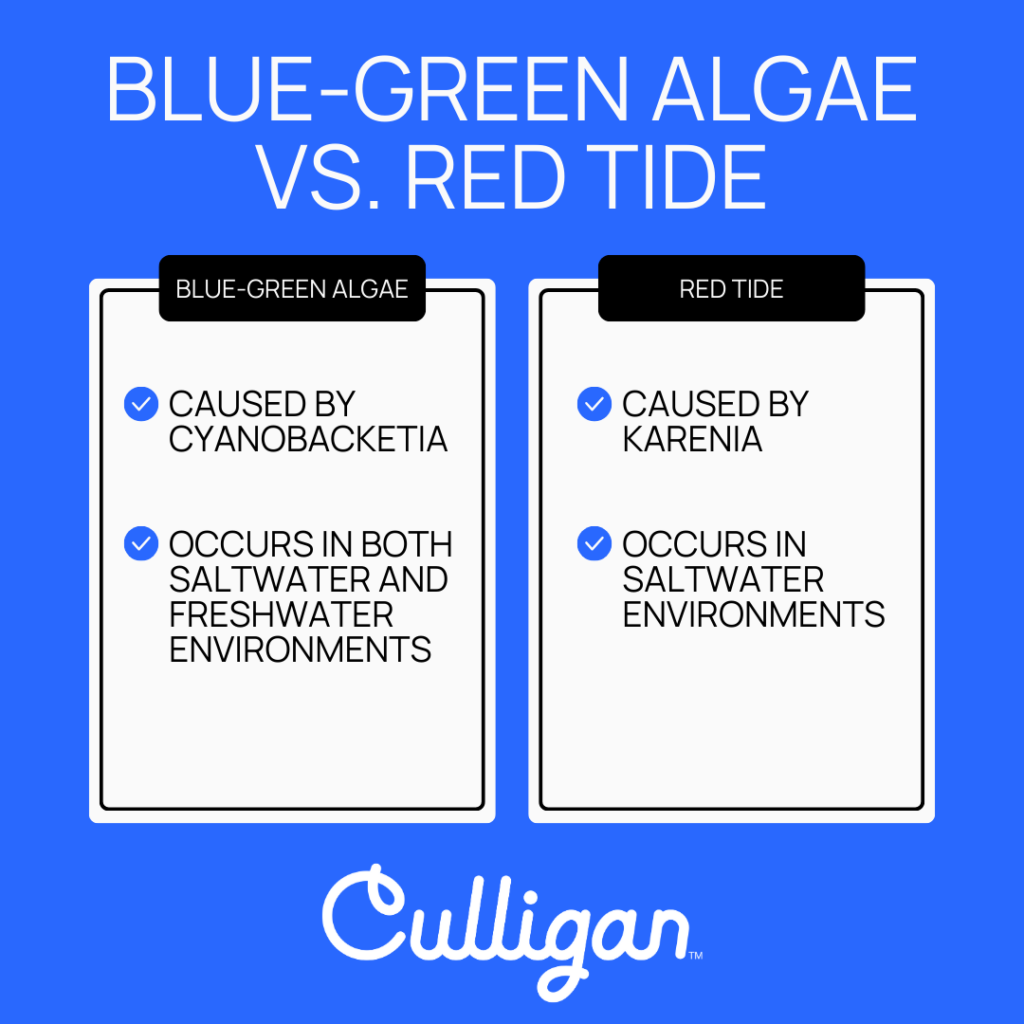Is Red Tide A Threat To Tampa Bay Tap Water Quality?
Red tide produces toxins in Tampa Bay that can harm marine life and cause health issues for humans, such as respiratory problems and skin irritation. But is it a threat to your home’s water supply?
Red tide is found in saltwater bodies such as Tampa Bay. These organisms can present a risk to drinking water when they create blooms in high concentrations.
Red tide is a type of algal toxin that is monitored in the Tampa Bay region. Red tide occurs when certain types of microscopic algae grow out of control and produce toxins that can harm marine life and potentially impact human health if contaminated seafood is consumed.
Like blue-green algae blooms, red tide outbreaks can be triggered by factors such as excess nutrients and warm temperatures. It is essential for water management agencies to closely monitor both blue-green algae and red tide levels to mitigate any potential risks to public health and the environment from these algal toxins.
Does Red Tide Affect Tampa Bay Water Quality?
The short answer is — probably not. Tampa Bay Water utilizes a monitoring and early warning system for algal blooms to safeguard their drinking water supplies. By actively monitoring sources for indicators of potential blooms and treatment methods such as ozone and biofiltration, as well as sensors and aeration, water quality is prevented from being affected by this issue.
The water system in Tampa area is diverse, including river sources, surface water treatment plants, and a seawater desalination plant. This provides flexibility in responding to conditions like red tide.
The use of reverse osmosis in the desalination plant effectively removes red tide toxins from seawater, ensuring customers don’t get contamination from the bay water.
“A major benefit of having such a diverse system is its flexibility. If our monitoring were to show potential for algal blooms in one source, we would switch to other sources, such as ground water, where algal toxins are not a concern”
Source: Tampabaywater.org

Costly Issues With Red Tide in Tampa Bay
Red tide is a common occurrence in oceans worldwide, where water appears discolored due to different organisms. In Florida, red tide specifically refers to an overabundance of the dinoflagellate algae Karenia brevis (K.Brevis), leading to harmful blooms.
Recent findings from a task force appointed by Florida Gov. Ron DeSantis suggest that the state’s algal bloom crisis is on the rise due to climate change and a growing population. This has sparked discussions among scientists and the public about their causes and impacts.
A 2018 red tide outbreak off the coast of central and southwest Florida devastated marine life and caused an estimated $184 million in damage to the local economy.
Source: tampabay.wateratlas.usf.edu
While some blooms are linked to pollution, it is difficult to directly connect man-made pollution to these blooms. However, nutrient pollution in coastal waters can worsen these blooms by providing food for algae like red tide.
One significant factor in their growth is phosphorus from fertilizer used in the Kissimmee River Basin, a region that feeds into the Everglades and flows into Lake Okeechobee before reaching the coasts through rivers and canals.
“A 2018 red tide outbreak off the coast of central and southwest Florida devastated marine life and caused an estimated $184 million in damage to the local economy.”
Source: tampabay.wateratlas.usf.edu
Blue-Green Algae Vs. Red Tide (K.Brevis)
Various types of naturally occurring algae can be found in surface waters. The Tampa Bay region monitors two main types of algal toxins: blue-green algae (cyanobacteria) and red tide.
Blue-green algae, or cyanobacteria, are frequently present in freshwater sources. Blooms of blue-green algae in our region are typically attributed to an abundance of nutrients, such as phosphate and nitrogen, along with increasing temperatures. These nutrients may enter water sources through various means, including wastewater, stormwater runoff, and agricultural runoff.
Both red tide, caused by Karenia brevis, and blue-green algae, caused by cyanobacteria, are triggered by excess nutrients and warm temperatures. It is important for water management agencies to carefully monitor both types of algae blooms, with red tide typically occurring in saltwater environments and blue-green algae able to grow in both freshwater and saltwater.

Additional Issues Affecting Tampa Bay Water Quality
- According to Tampa Waterkeeper, stormwater runoff is the most significant source of pollution within the watershed — accounting for roughly 59% of the total nitrogen loading in Tampa Bay.
- Phosphate mining in the region has had a notable impact on water quality and public health, with concerns about environmental effects persisting for many years. The 2021 red tide event highlighted the harmful algal blooms due to human-induced nutrient pollution.
- Additionally, release of wastewater from the Piney Point gypsum stacks during this event caused respiratory issues, skin irritation, and economic losses.
- The tradition of dyeing the Hillsborough River green for St. Patrick’s Day is facing scrutiny over environmental worries. Despite assurances that the dye is safe and biodegradable, public opinion, as shown by a petition with 5,000 signatures, is pushing for a reexamination.
Is Tampa Water Safe to Drink?
Tampa’s tap water is considered legally safe to drink by local and federal standards, but it still contains a variety of contaminants, including lead, arsenic, PFAS, chromium, and disinfection byproducts like TTHMs and HAA5—many of which exceed health guidelines set by the Environmental Working Group. While most of Tampa’s water comes from the Hillsborough River and is treated before distribution, factors like aging infrastructure, runoff, and natural deposits contribute to lingering impurities. Residents may also experience common issues such as hard water, sulfur odors, and turbidity. For those concerned about long-term health effects or water quality, Culligan offers in-home testing and solutions like reverse osmosis and whole-house filtration systems to ensure cleaner, safer drinking water.
